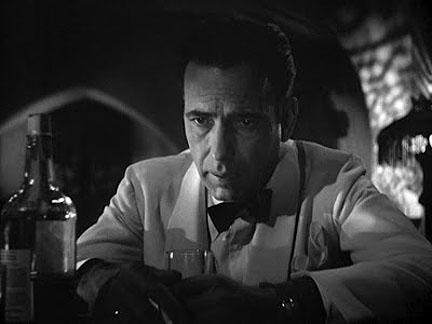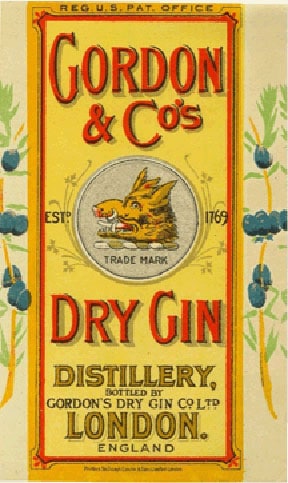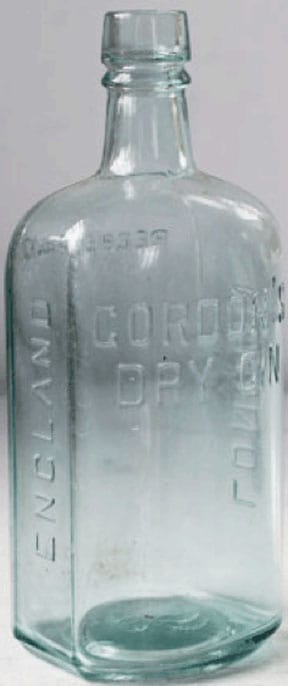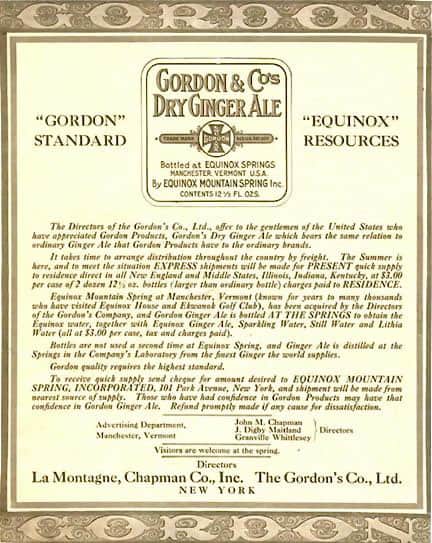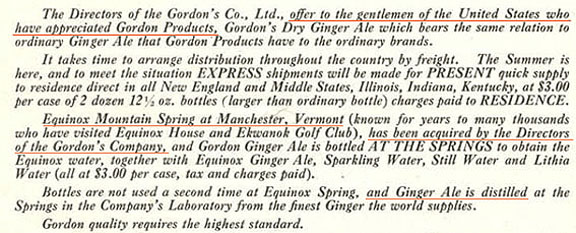Don’t Bogart that Gin . . . ger Ale
01 November 2013
The ad also reveals that Gordon & Co. purchased the Equinox Springs bottling business in Manchester, Vermont.
![]() Another post from Ginger Ale authority Ken Previtali. This will join the very popular Ginger Ale Page on Peachridge Glass.
Another post from Ginger Ale authority Ken Previtali. This will join the very popular Ginger Ale Page on Peachridge Glass.
Your PRG post on African gins included an iconic picture of Humphrey Bogart removing a Gordon & Co. gin bottle from a case on the deck of the African Queen. Here’s what the color label looks like (see above) on a bottle from that era. It reminded me of this ginger ale from the 1920s (see below). The typography is identical!
The question is, why a world-famous gin distiller like Gordon & Co. was producing ginger ale in this country, and how did that endeavor come about? The brand goes back to 1769 when Alexander Gordon opened a distillery in London. By 1800, sailors of the British Navy were carrying his gin around the world. Fast forward over 100 years and the first Gordon’s overseas agent, J. Digby Maitland, began making trips to the United States. By then, hundreds of thousands of Gordon’s gin bottles like this one (see below) were being exported to the U.S.
Move ahead to 1918 and prohibition. We often think about the impact prohibition had on our domestic distillers and breweries but forget that companies around the world were losing their lucrative U.S. export market practically overnight. This magazine advertisement (see below) from 1919 documents how Gordon & Co. tried to retain a presence in the U.S. and make some money. (You’ll see the agent J. Digby Maitland listed as a director).
The advertisement copy slyly refers to prohibition by addressing the “gentlemen in the U.S.” who couldn’t get Gordon’s gin any more (legally anyway). The text goes on to emphasize the reputation of Gordon’s brand to help sell the ginger ale. The ad also reveals that Gordon & Co. purchased the Equinox Springs bottling business in Manchester, Vermont. The use of the word distilled is interesting because it is misleading; ginger ale was never “distilled”. This tricky copywriting might have been intended to lead the reader to believe that alcohol was surreptitiously associated with Gordon’s ginger ale. Most likely what the text was referring to, in a vague way, was how they made the ginger ale flavor extract which might have used a distilling process, but that’s not the impression the reader is given!
The ad also refers to the “Equinox House” (see advertisement detail above) where the spring water of the same name was served regularly. The Equinox House story goes back to the same year that Alexander Gordon started distilling his “juniper recipe” in London. It’s worth a visit to the Equinox House history page, just to imagine all the bottles and glassware that graced the tables of this historic inn over more than 200 years’ time. Some of which were bottles of ginger ale. . .
Ken (Previtali)

